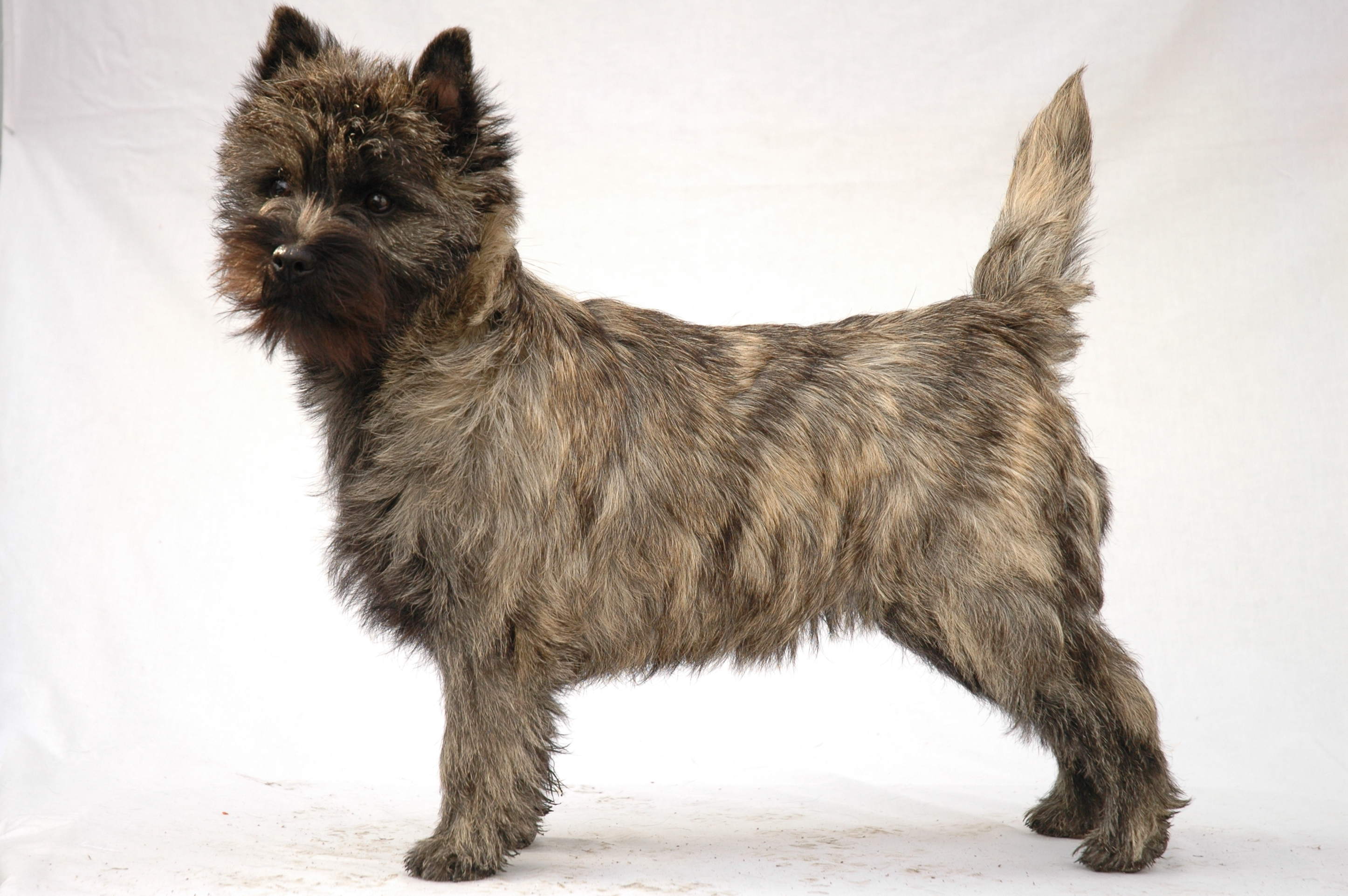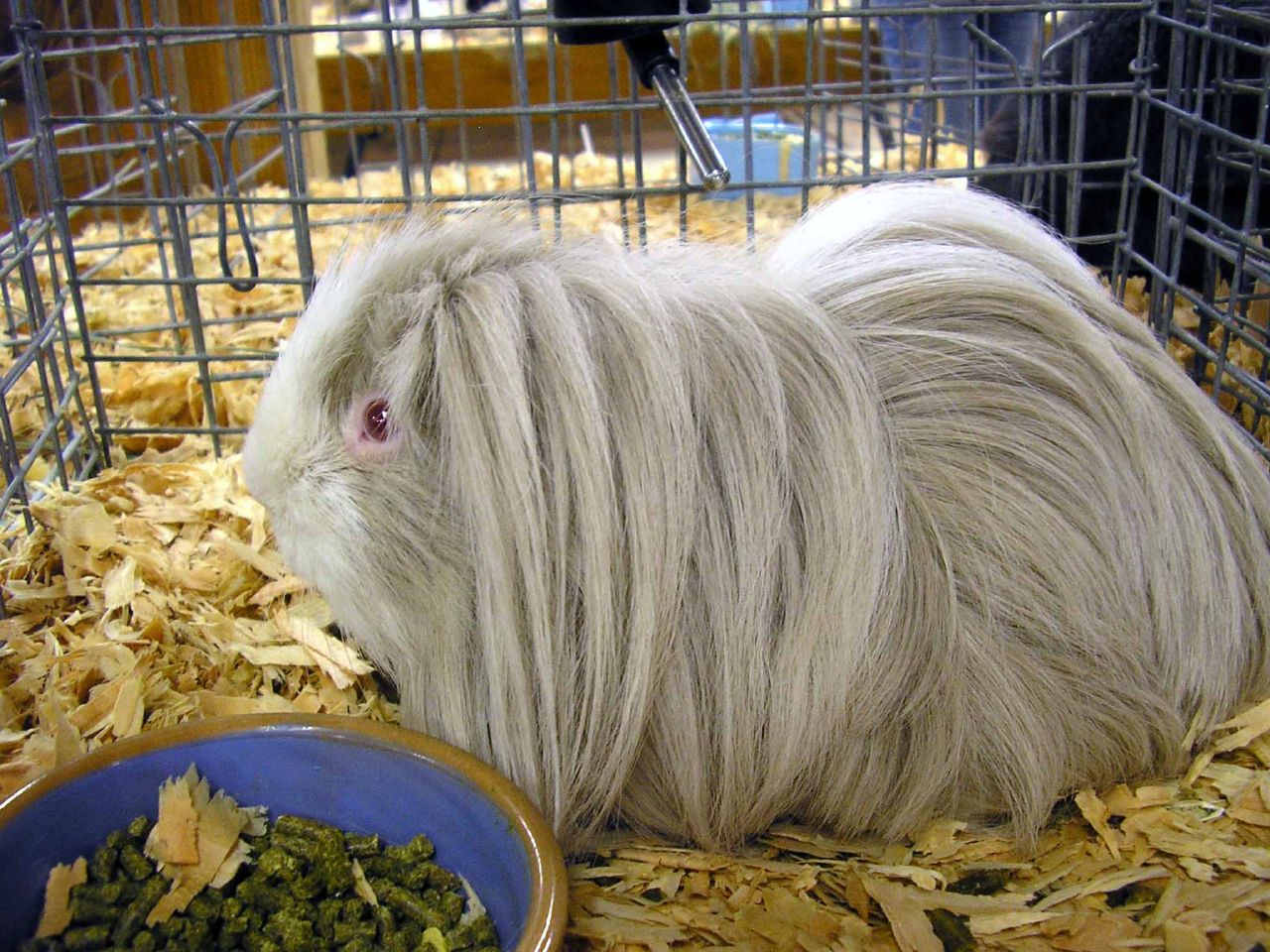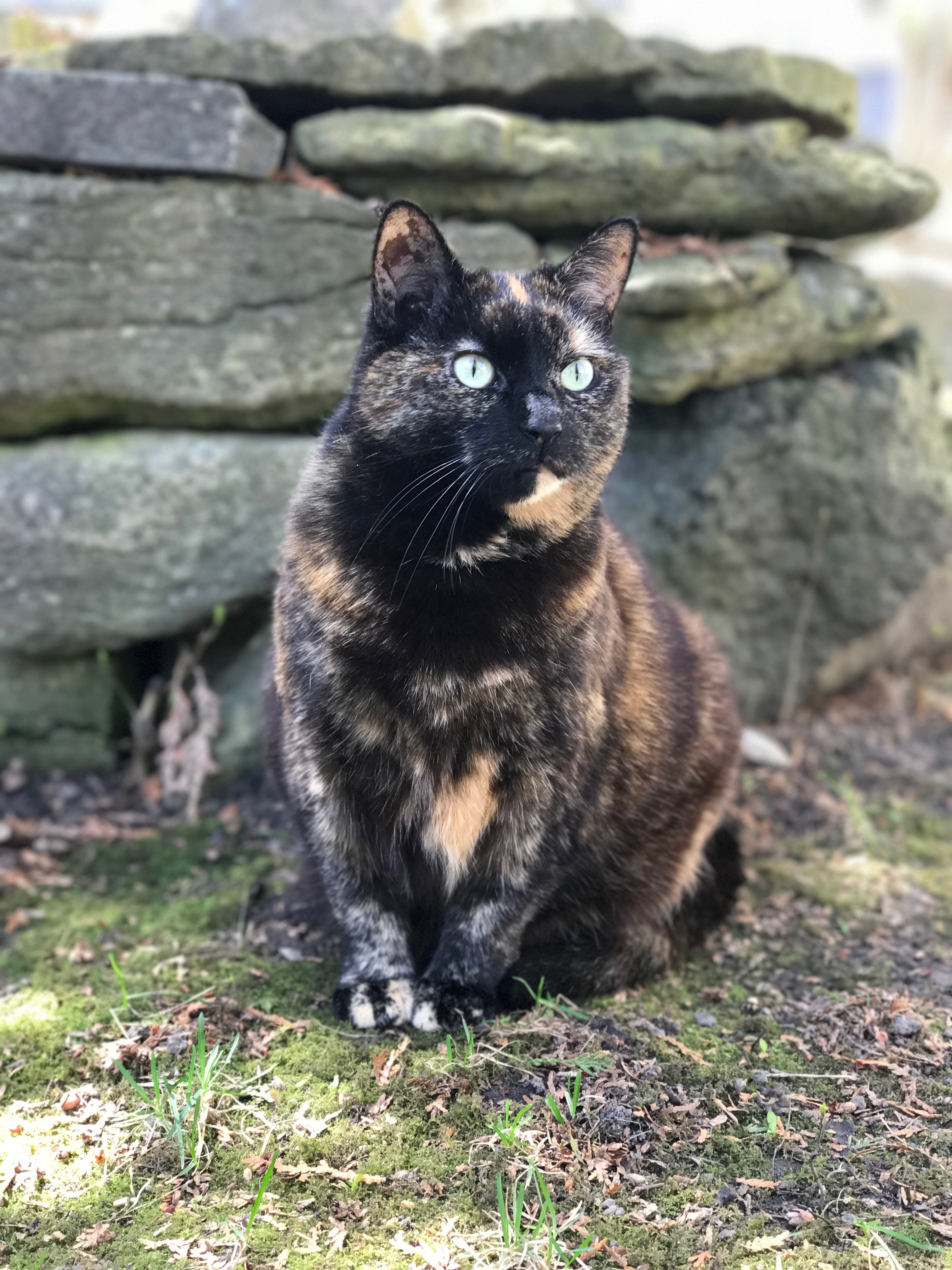|
Brindle
Brindle is a coat (animal), coat coloring pattern in animals, particularly dogs, cattle, guinea pigs, Cat, cats, and, rarely, horses. It is sometimes described as "tiger-striped", although the brindle pattern is more subtle than that of a tiger's coat. Brindle typically appears as black stripes on a red base. The stripes are eumelanin (black/brown pigment) and the base is phaeomelanin (red/yellow pigment), so the appearance of those pigments can be changed by any of the genes which usually affect them. * Eumelanin (the pigment making up the stripes) can be affected by: merle (and harlequin), liver, dilution, greying, and recessive red. * Phaeomelanin (the pigment making up the base) can be affected by: Intensity locus. And of course, white markings and ticking can occur on any brindle dog. Brindle is caused by a complex gene process and is technically a form of mosaicism, where some cells express one allele (KB) and other cells express a different allele (ky), a little like t ... [...More Info...] [...Related Items...] OR: [Wikipedia] [Google] [Baidu] |
Brindled Domestic Short-haired Cat
Brindle is a coat coloring pattern in animals, particularly dogs, cattle, guinea pigs, cats, and, rarely, horses. It is sometimes described as "tiger-striped", although the brindle pattern is more subtle than that of a tiger's coat. Brindle typically appears as black stripes on a red base. The stripes are eumelanin (black/brown pigment) and the base is phaeomelanin (red/yellow pigment), so the appearance of those pigments can be changed by any of the genes which usually affect them. * Eumelanin (the pigment making up the stripes) can be affected by: merle (and harlequin), liver, dilution, greying, and recessive red. * Phaeomelanin (the pigment making up the base) can be affected by: Intensity locus. And of course, white markings and ticking can occur on any brindle dog. Brindle is caused by a complex gene process and is technically a form of mosaicism, where some cells express one allele (KB) and other cells express a different allele (ky), a little like tortoiseshell cats. T ... [...More Info...] [...Related Items...] OR: [Wikipedia] [Google] [Baidu] |
Cairn Terrier
The Cairn Terrier is a terrier breed originating in the Scottish Highlands and recognized as one of Scotland's earliest working dogs. The breed was given the name Cairn because the breed's function was to hunt and chase quarry between the cairns in the Scottish highlands. Although the breed had existed long before, the name Cairn Terrier was a compromise suggestion after the breed originally was brought to official shows in the United Kingdom in 1909 under the name Short-haired Skye terriers. This name was not acceptable to The Kennel Club due to opposition from Skye Terrier breeders, and the name Cairn Terrier was suggested as an alternative. History Cairns originated in the Scottish Highlands and the Isle of Skye, initially grouped in the "Skye Terrier" class alongside the Scottish and West Highland White Terriers. In the early 1900s, the three breeds began to be bred separately. The Kennel Club of the United Kingdom gave the Cairn Terrier a separate register in 1912; the ... [...More Info...] [...Related Items...] OR: [Wikipedia] [Google] [Baidu] |
Guinea Pig Breed
There are many breeds of guinea pig or cavy which have been developed since its domestication circa 5000 BCE. Breeds vary widely in appearance and purpose, ranging from show breeds with long, flowing hair to laboratory breeds being used as model organisms for science. From roughly 1200 to 1532 CE (during the Spanish conquest of the Inca Empire), selective breeding by indigenous South American people resulted in many landrace varieties of domestic guinea pigs, which form the basis for some formal modern breeds. Early Andean varieties were primarily kept as agricultural stock for food, and efforts at improving cavy breeds (''cuy'') bred for food continue to the modern era, with entirely separate breeds that focus on size and disease resistance. With the export of guinea pigs to Europe in the 15th century, the goal in breeding shifted to focus on the development of appealing pets. To this end, various competitive breeding organizations were founded by fanciers. The American Cavy ... [...More Info...] [...Related Items...] OR: [Wikipedia] [Google] [Baidu] |
Tricolor (dog)
The coat of the domestic dog refers to the hair that covers its body. Dogs demonstrate a wide range of coat colors, patterns, textures, and lengths. As with other mammals, a dog's fur has many uses, including thermoregulation and protection from cuts or scratches; furthermore, a dog's coat plays an important role in the showing of purebred dogs. Breed standards often include a detailed description of the nature and attributes of that breed's ideal coat. A dog's coat is composed of two layers: a top coat of stiff guard hairs that help repel water and shield from dirt, and an undercoat of soft down hairs, to serve as insulation. Dogs with both under coat and top coat are said to have a ''double coat''. Dogs with a ''single coat'' have a coat composed solely of guard hairs, with little or no downy undercoat. The terms fur and hair are often used interchangeably when describing a dog's coat, however in general, a double coat, like that of the Newfoundland and most livestock guar ... [...More Info...] [...Related Items...] OR: [Wikipedia] [Google] [Baidu] |
Cardigan Welsh Corgi
The Cardigan Welsh Corgi (; Welsh for "dwarf dog") is one of two separate dog breeds known as Welsh Corgis that originated in Wales; the other is the Pembroke Welsh Corgi. It is one of the oldest breeds of the British Isles. Cardigan Welsh Corgis are known to be an extremely loyal dog breed. They are also versatile and can live in a variety of settings. History Pembroke and Cardigan Welsh Corgis were originally listed as one breed by The Kennel Club in Britain in 1925, but were declared separate breeds in 1935. The Corgi Club was founded in December 1925 in Carmarthen in South Wales. It is reported that the local members favored the Pembroke breed, so a club for Cardigan enthusiasts was founded a year later (1926). Both groups have worked hard to ensure the appearance and type of breed are standardized through careful selective breeding. Pembrokes and Cardigans were officially recognized by the Kennel Club in 1928 and were lumped together under the heading Welsh Corgis. In 1934, ... [...More Info...] [...Related Items...] OR: [Wikipedia] [Google] [Baidu] |
Basenji
The Basenji ( /bəˈsɛndʒi/) is a breed of hunting dog. It was bred from stock that originated in central Africa. The Fédération Cynologique Internationale places the breed in the Spitz and primitive types. The Basenji produces an unusual yodel-like sound, due to its unusually shaped larynx. This trait also gives the Basenji the nickname the 'barkless dog.' Basenjis share many distinctive traits with pariah dog types. Basenjis come into estrus only once annually similar to dingoes, New Guinea singing dogs and Tibetan Mastiffs, when compared with other dog breeds which may have two or more breeding seasons each year. Basenji lack a distinctive odor, and are prone to howls, yodels, and other vocalizations over the characteristic bark of modern dog breeds. The breed's original foundation stock came from the Democratic Republic of the Congo. Name The Azande and Mangbetu people from the northeastern Congo region describe a Basenji, in the local Lingála language, as , mea ... [...More Info...] [...Related Items...] OR: [Wikipedia] [Google] [Baidu] |
Merle (coat Colour In Dogs)
Merle is a genetic pattern that can be in a dog's coat. Merle comes in different colors and patterns and can affect all coat colors. The merle gene creates mottled patches of color in a solid or piebald coat, blue or odd-colored eyes, and can affect skin pigment as well. There are two general types of colored patches that will appear in a merle coat: liver (red merle) and black (blue merle). Some breeds that can be affected by this genetic trait are Carea Leonés, Australian Shepherds and Catahoula Leopard Dogs. This genetic trait should be taken seriously when breeding merles. Health issues are more typical and more severe when two merles are bred together, so it is recommended that a merle be bred with a non-merle dog of any other color. Description Merle can affect all coat colors. The merle forms of brown and black are usually called "red" (though this is not correct; red and brown are genetically different) and "blue" as patches of blue are formed throughout the coat. D ... [...More Info...] [...Related Items...] OR: [Wikipedia] [Google] [Baidu] |
Tortoiseshell Cats
Tortoiseshell is a cat coat coloring named for its similarity to tortoiseshell material. Like calicoes, tortoiseshell cats are almost exclusively female. Male tortoiseshells are rare and are usually sterile.Atkins (2003), p.105 Tortoiseshell cats, or torties, combine two colors other than white, either closely mixed or in larger patches. The colors are often described as red and black, but the "red" patches can instead be orange, yellow, or cream, and the "black" can instead be chocolate, gray, tabby, or blue. Tortoiseshell cats with the tabby pattern as one of their colors are sometimes referred to as torbies or torbie cats. "Tortoiseshell" is typically reserved for particolored cats with relatively small or no white markings. Those that are predominantly white with tortoiseshell patches are described as tricolor, tortoiseshell-and-white (in the United Kingdom), or calico (in Canada and the United States). Cats with a tortoiseshell pattern and small blotches of white are some ... [...More Info...] [...Related Items...] OR: [Wikipedia] [Google] [Baidu] |
Tortoiseshell Cat
Tortoiseshell is a cat animal coloration, coat coloring named for its similarity to tortoiseshell material. Like calico cat, calicoes, tortoiseshell cats are almost exclusively female. Male tortoiseshells are rare and are usually sterile.Atkins (2003), p.105 Tortoiseshell cats, or torties, combine two colors other than white, either closely mixed or in larger patches. The colors are often described as red and black, but the "red" patches can instead be orange, yellow, or cream, and the "black" can instead be chocolate, gray, tabby cat, tabby, or blue. Tortoiseshell cats with the tabby cat, tabby pattern as one of their colors are sometimes referred to as torbies or torbie cats. "Tortoiseshell" is typically reserved for particolored cats with relatively small or no white markings. Those that are predominantly white with tortoiseshell patches are described as tricolor, tortoiseshell-and-white (in the United Kingdom), or calico cat, calico (in Canada and the United States). Cats wi ... [...More Info...] [...Related Items...] OR: [Wikipedia] [Google] [Baidu] |
Equine Coat Color
Horses exhibit a diverse array of coat colors and distinctive markings. A specialized vocabulary has evolved to describe them. While most horses remain the same color throughout life, a few, over the course of several years, will develop a different coat color from that with which they were born. Most white markings are present at birth, and the underlying skin color of a healthy horse does not change. Some Equine coat colors are also related to the breed of horse, like the Friesian breed for instance. The basic outline of equine coat color genetics has largely been resolved, and DNA tests to determine the likelihood that a horse will have offspring of a given color have been developed for some colors. Discussion, research, and even controversy continues about some of the details, particularly those surrounding spotting patterns, color sub-shades such as "sooty" or " flaxen", and markings. Basic coat colors The two basic pigment colors of horse hairs are pheomelanin ("red") ... [...More Info...] [...Related Items...] OR: [Wikipedia] [Google] [Baidu] |
X-linked
Sex linked describes the sex-specific patterns of inheritance and presentation when a gene mutation (allele) is present on a sex chromosome (allosome) rather than a non-sex chromosome (autosome). In humans, these are termed X-linked recessive, X-linked dominant and Y-linked. The inheritance and presentation of all three differ depending on the sex of both the parent and the child. This makes them characteristically different from autosomal dominance and recessiveness. There are many more X-linked conditions than Y-linked conditions, since humans have several times as many genes on the X chromosome than the Y chromosome. Only females are able to be carriers for X-linked conditions; males will always be affected by any X-linked condition, since they have no second X chromosome with a healthy copy of the gene. As such, X-linked recessive conditions affect males much more commonly than females. In X-linked recessive inheritance, a son born to a carrier mother and an unaffected fath ... [...More Info...] [...Related Items...] OR: [Wikipedia] [Google] [Baidu] |
Semidominant
In genetics, dominance is the phenomenon of one variant (allele) of a gene on a chromosome masking or overriding the effect of a different variant of the same gene on the other copy of the chromosome. The first variant is termed dominant and the second recessive. This state of having two different variants of the same gene on each chromosome is originally caused by a mutation in one of the genes, either new (''de novo'') or inherited. The terms autosomal dominant or autosomal recessive are used to describe gene variants on non-sex chromosomes ( autosomes) and their associated traits, while those on sex chromosomes (allosomes) are termed X-linked dominant, X-linked recessive or Y-linked; these have an inheritance and presentation pattern that depends on the sex of both the parent and the child (see Sex linkage). Since there is only one copy of the Y chromosome, Y-linked traits cannot be dominant or recessive. Additionally, there are other forms of dominance such as incomplete d ... [...More Info...] [...Related Items...] OR: [Wikipedia] [Google] [Baidu] |









